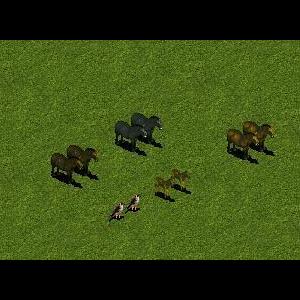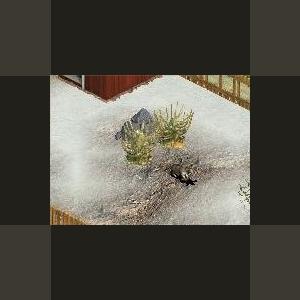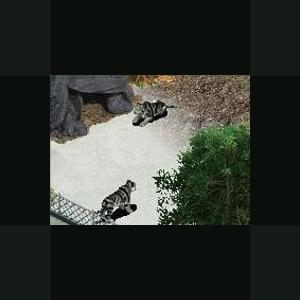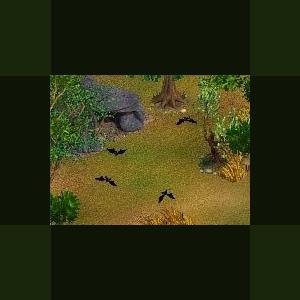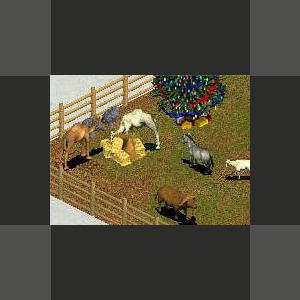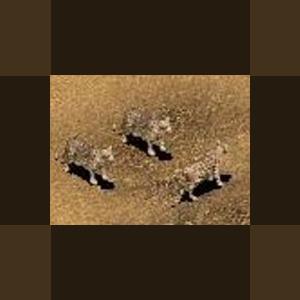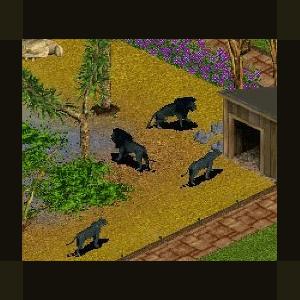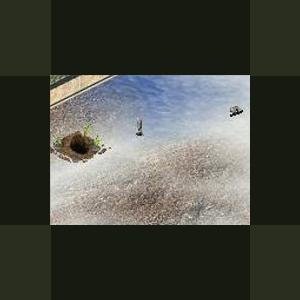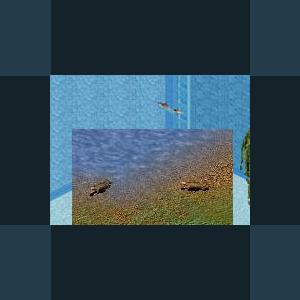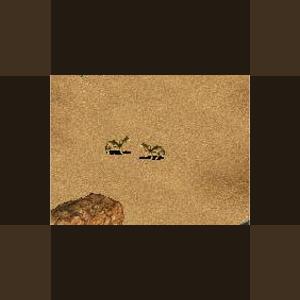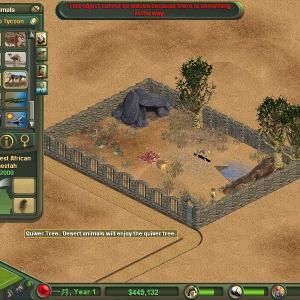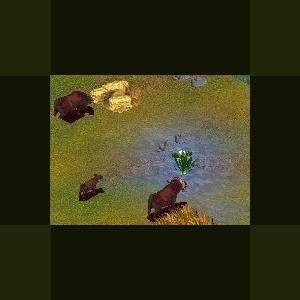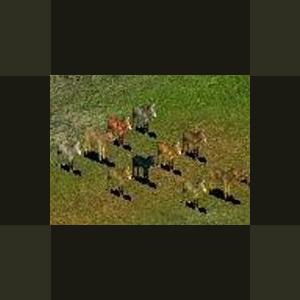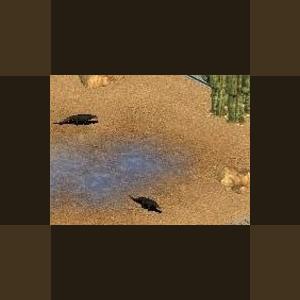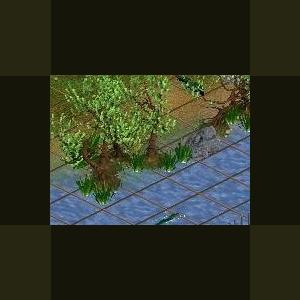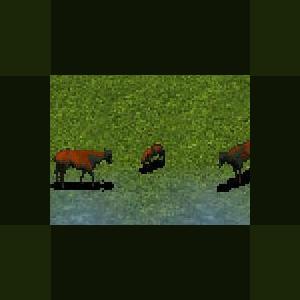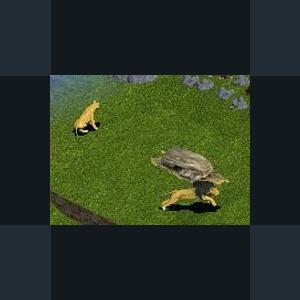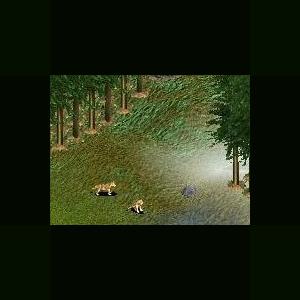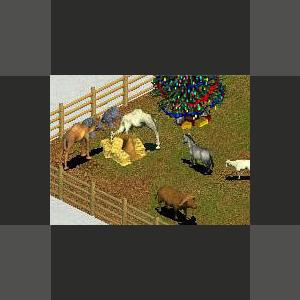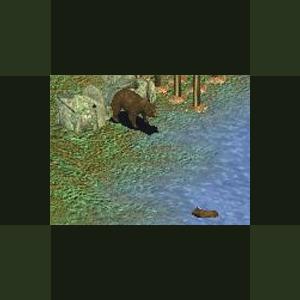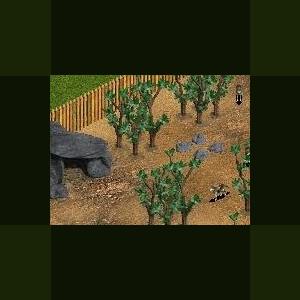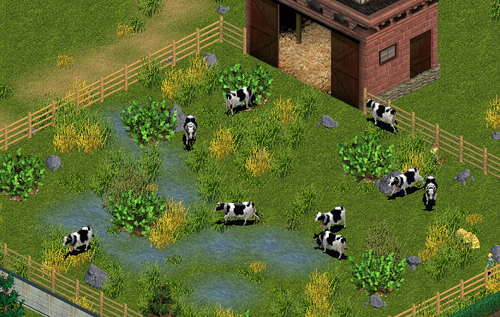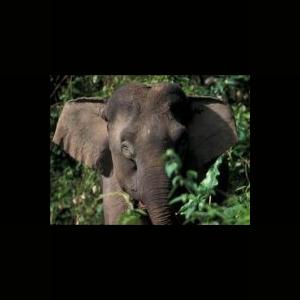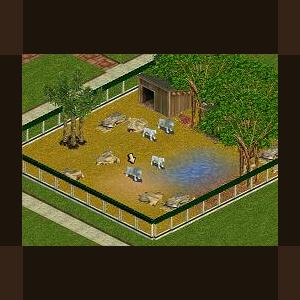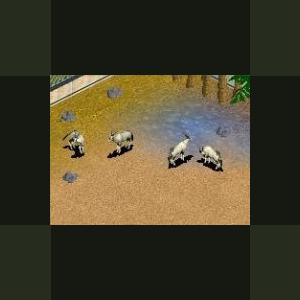279 files
-
American Pack by And 1
By Fern
Creator : And 1
This pack is a small American animal pack. Animals: Black Mustang, Brown Mustang, Dark Brown Mustang, American Kestrel, and the Mesohippus.
Originally released at ZA 2004. Thank you And1 for allowing permission for the updated file to be loaded at Tek and DG as well as ZA.
Updated : August 22, 2011 by JohnRN1 to remove unused files, to change their Location to North America, to have the foliage tooltip appear in the expansion packs for the female and young, to remove unneeded lines in the configuration, and to make all of the sounds work. (Thanks, JohnRN1!) New sounds were added for the kestrel. In order to make the file smaller, the Przewalski's Wild Horse sounds were removed from the file for the mustangs and they were replaced with links to the Przewalski's Wild Horse's sounds. So you will need CC or the Endangered Species Download pack in order to hear those sounds. The original mustangs also had the same problem as the Przewalski's Wild Horse and showed the wrong animation for when the young got sick. That has been corrected. Some spaces and punctuation were added to the animal info and purchase menu tooltips. The adult kestrel poo was changed to the small type. The kestrel egg was changed to not move, to not need food or drink, to not poo, to not get sick, to not get angry, and to tolerate crowds.
495 downloads
0 comments
Updated
-
Caribou by Hersheyqwert
By Guest
Caribou by Hersheyqwert
Recolor of the Reindeer. The animations has been deleted when they "flew" or anything else with the sparkles. They need snow, grey stone, grass, freshwater, and some dirt in their exhibits. They like a stable and some elevation. They like both the sage bush and tundra plants.
Updated 2010-10-30
Just to save space with less in zip and smaller image.
494 downloads
0 comments
Updated
-
Maltese Tiger by Jordan
By Guest
The Maltese Tiger or Blue Tiger (Panthera tigris melitensis) is an extremely rare color morph of tiger that has historically been reported in the Fujian Province of China and has only been sighted on a few occasions.
It is said to have bluish fur with dark gray stripes. The term "Maltese" means "slate gray" and comes from the domestic cat world; it does not refer to Malta as the origin of the blue tigers.
Updated 2010-11-03
Just to save space with less in zip and smaller image.
Nothing new.
494 downloads
0 comments
Updated
-
Pemba Flying Fox by Genkicoll
By Guest
The Pemba flying fox is a large fruit bat weighing 400 - 650 g (0.9 - 1.4 lb). Its diet consists of the fruit and flowers of a number of plants.
Primary and secondary forest, graveyards and mangroves provide roosting sites. The Pemba flying fox is very social and has been found in large colonies until recently.
The Pemba flying fox is found only on Pemba Island, Tanzania. The island was originally forested, but only remnants of the primary forest remain. Estimates of the status of the Pemba flying fox have varied considerably recently. Studies in 1989 suggested a dramatic population decline, with fewer than 10 individuals being seen, and the species was considered to be on the brink of extinction. However, in 1992, surveys indicated a population in the region of 2400-3600, although it was estimated that the population may have declined significantly in the preceding decade. (Entwistle & Corp 1997)
Habitat loss from deforestation is a major concern, since the last fragments of natural forest are now in danger of disappearing (Seehausen 1991). Pemba islanders hunt bats only for subsistence purposes, not for commercial purposes. Currently, the villagers appear mainly to use traditional hunting methods. If the use of shotguns increases, hunting could become more of a threat.
Source: Professor Paul's Nature Encyclopedia
Many thanks to Ziggy for the original gif animations.
Updated 2010-11-05
Just to save space with less in zip and smaller image.
Nothing new.
490 downloads
Updated
-
Christmas Animals Part 1 by Ghirin
By Guest
Christmas animals part 1
Oxen are large animals valued for their meat, hide, and milk.
They enjoy the company of other Christmas Petting Zoo animals.
Brown Dromedary camels are the typical "camel" color.
They enjoy the company of other Christmas Petting Zoo animals.
Donkeys have been domesticated for approximately 6000 years.
They enjoy the company of other of Christmas Petting Zoo animals.
Updated 2010-10-30
Just to save space with less in zip and smaller image.
Nothing new.
488 downloads
0 comments
Updated
-
Persian Leopard by Moondawg
By Guest
Persian Leopard
The Persian leopard (Panthera pardus saxicolor), or Iranian leopard, is one of the leopard subspecies native to western Asia. It is endangered throughout its range in the Middle East.
The Persian leopard is said to be the largest of all the subspecies of leopards in the world. It can grow to up to 1.5 to 2.7 feet tall at the shoulder, and weigh as much as 155 lbs. Before 1990, when Armenia, Azerbaijan, Georgia, Russia, and Turkmenistan were the Soviet republics, the scientific names of the leopard used in these countries were P.p. tulliana and P.p. ciscaucasica, whereas the name P.p. saxicolor had been traditionally used by the western specialists for the cats in Iran and, partially, Afghanistan. There are currently a few hundred left in the world.
It is found in Iran, Azerbaijan, Armenia, Turkmenistan, Uzbekistan, Tajikistan, and northwestern Afghanistan. Habitat varies from mountain steppe to grasslands, or anywhere having a reasonable amount of cover and a supply of prey. Unconfirmed reports of big cats in the far southeast of Turkey might also pertain to these animals; see the Caspian Tiger article for details.
Updated 2010-11-05
Just to save space with less in zip and smaller image.
Nothing new.
487 downloads
0 comments
Updated
-
Black Lions by JohnT (JohnRN1)
By Fern
Thank you for downloading the Black Lions. This rare colored animal is dedicated to our friend Caddie for his love of animals. Enjoy.
"Move the .ztd file into the dlupdate (and not dupdate) folder if one exists in your Zoo Tycoon folder; otherwise move the .ztd file into the Updates folder that is in the Zoo Tycoon folder."
The default is C:\Program Files\Microsoft Games\Zoo Tycoon
Thank you to Fern and Jay for their invaluable encouragement guidance, and expertise. And, thanks to in game testers at DD.
--JohnT--
486 downloads
0 comments
Updated
-
Ermine by Jordan
By Guest
The Ermine, also known as a stoat when not in its winter coat, is found in temperate and arctic regions throughout the northern hemisphere and is a member of the weasel family.
Updated 2010-11-03
Just to save space with less in zip and smaller image.
Nothing new.
481 downloads
0 comments
Updated
-
European Otter by BigCatKeeper
By Guest
European Otter
Author: BigCatKeeper
http://www.zoo-tek.com/forums/index.php?download=161
With the exception of the fox and wildcat all British carnivores belong to the family known as mustelids (the weasel family) of which there are 8 member species in the UK. All tend to be characterised by long sinuous bodies and short legs (the powerful build of the badger is an exception to this, but this animal is highly distinctive because of its facial strips and size).
The Otter is a secretive semi-aquatic member of the mustelid family, once widespread in Britain where it was found living on rivers and inland waterways and in certain coastal areas.
In the late 1950's and early 1960's pollution, hunting and loss of habitat caused a serious decline in the otter population, not only here in Britain but throughout Europe.
Today, with strict protection from the Wildlife and Countryside Act anti-pollution laws resulting in cleaner rivers, and river banks environmentally managed to provide secluded undisturbed habitats, the otter population is once again on the increase with many sightings in their former habitats.
Otters in the wild are extremely shy and rarely seen. During the day they tend to lie up in suitable cover on the river bank only becoming active at dawn and dusk when riverbanks and waterways are at their quietest, allowing them to hunt for food undisturbed.
Fish make up the greater part of an otter's diet with eels being a particular favourite, but they will also take water fowl, moorhens, coots and ducks and anything else that is edible living along the riverbank.
European Otter created by Bigcatkeeper
Thanks to Professorpaul
Updated 2010-11-03
Just to save space with less in zip and smaller image.
Nothing new
480 downloads
0 comments
Updated
-
Arabian Wolf by Ghirin
By Guest
Arabian Wolf by Ghirin
The Arabian wolf (Canis lupus arabs) is an endangered subspecies of wolf from the Middle East. Unlike northern wolves, Arabian wolves live in pairs or small groups.
Reference:
www.Wikipedia.com
Created by Ghirin 2006
Updated 2010-10-30
Just to save space with less in zip and smaller image.
Nothing new.
471 downloads
0 comments
Updated
-
Northwest African Cheetah by RDingFT
By Fern
Northwest African Cheetah
Author : RDingFT
Compatibility : All Game Versions
Well I used the cheetah to create a new animal : Northwest African Cheetah :)
To reskin the cheetah, I used Markhor.pal.
The Northwest African Cheetah (Acinonyx jubatus hecki), also known as the Saharan Cheetah, is a subspecies of cheetah found in the northwestern part of Africa (particularly the central western Sahara desert and the Sahel). It is classified as critically endangered, with a total world population estimated to be about 250 mature individuals.
468 downloads
Updated
-
Hereford Cow by Genkicoll
By Guest
Made by request, a special surprise for Menolly.
The Hereford breed was founded some two and one-half centuries ago as a product of necessity. Thrifty and enterprising farmers near Hereford in the County of Herefordshire, England, were determined to produce beef for the expanding food market created by Britain's industrial revolution. To succeed in Herefordshire, these early-day cattlemen realized they must have cattle which could efficiently convert their native grass to beef and do it at a profit.
There was no breed in existence at the time to fill that need, so the farmers of Herefordshire founded the beef breed that logically became known as Herefords. These early Hereford breeders molded their cattle with the idea in mind of a high yield of beef and efficiency of production, and so firmly fixed these characteristics that they remain today as outstanding characteristics of the breed.
Beginning in 1742 with a bull calf from the cow Silver and two cows, Pidgeon and Mottle, inherited from his father's estate, Benjamin Tomkins is credited with founding the Hereford breed. This was 18 years before Robert Bakewell began developing his theories of animal breeding. From the start, Mr. Tomkins had as his goals economy in feeding, natural aptitude to grow and gain from grass and grain, rustling ability, hardiness, early maturity and prolificacy, traits that are still of primary importance today.
Other pioneering breeders were to follow the Tomkins' lead and establish the world-wide renown for the Herefordshire cattle causing their exportation from England to wherever grass grows and beef production is possible.
Herefords in the 1700's and early 1800's in England were much larger than today. Many mature Herefords of those days weighed 3,000 pounds or more. Cotmore, a winning show bull and noteworthy sire, weighed 3,900 pounds when shown in 1839. Gradually, the type and conformation changed to less extreme size and weight to get more smoothness, quality and efficiency.
Source: http://www.ansi.okstate.edu/breeds/cattle/hereford/
*NOTE: 100% compatible with the prairie peafowl by Genki and the silkies made by Sundance.
Updated 2010-11-03
Just to save space with less in zip and smaller image.
Nothing new
465 downloads
Updated
-
Evolution of the Horses Pack by Moondawg
By Guest
Evolution of the Horse Pack by Moondawg - Combined
The horse belongs to an order known as the Perissodactyls, or "odd-toed ungulates", which all share hoofed feet and an odd number of toes on each foot.
Horses appeared to be absent from the Americas until the Spanish Conquistadors brought domestic horses from Europe in the 16th Century, and escaped horses quickly established large wild herds. The early naturalist Buffon suggested in the 1760s that this was an indication of inferiority of fauna in the New World, then later reconsidered this idea.
William Clark's 1807 expedition to Big Bone Lick found "leg and foot bones of the Horses" which were included with other fossils sent to Thomas Jefferson and evaluated by the anatomist Caspar Wistar, but neither commented on the significance of this find.
During the Beagle survey expedition the young naturalist Charles Darwin had remarkable success with fossil hunting in Patagonia. On 10 October 1833 at Santa Fe, Argentina, he was "filled with astonishment" when he found a horse's tooth in the same stratum as fossil
giant armadillos, and wondered if it might have been washed down from a later layer, but concluded that this was "not very probable". After the expedition returned in 1836 the anatomist Richard Owen confirmed that the tooth was from an extinct species which he subsequently named Equus curvidens, and remarked that "This evidence of the former existence of a genus, which, as regards South America, had become extinct, and has a second time been introduced into that Continent, is not one of the least interesting fruits of Mr. Darwin's palæontological discoveries."
In 1848 a study on the fossil horses of America by Joseph Leidy systematically examined Pleistocene horse fossils from various collections including that of the Academy of Natural Sciences and concluded that there hadbeen at least two ancient horse species in North America, Equus curvidens and another which he named Equus americanus, but a decade later he found that name had already been taken and renamed it Equus complicatus. In the same year he visited Europe and was introduced by Owen to Darwin.
Also included in this pack is the Hipparion and the Merychippus both files have been updated to work with ZT so you won't need DD or CC to use them.
This pack is a combined pack so if you already have Hipparion and Merychippus then the single files will nee to be removed from the update or dlupdate folder.
Updated 2010-11-03
Just to save space with less in zip and smaller image.
Nothing new.
464 downloads
0 comments
Updated
-
Mexican Beaded Lizard by Jordan
By Guest
The Mexican Beaded Lizard is a venomous reptile found in the deserts of Mexico and the southwestern USA.
Updated 2010-11-03
Just to save space with less in zip and smaller image.
Nothing new.
463 downloads
0 comments
Updated
-
Chinese Alligator by Coolperson5
By Guest
The Chinese Alligator is an endangered species of alligator that resides in the Yangtze River in China.
Created by Coolperson5
Updated 2010-10-30
Just to save space with less in zip and smaller image.
Nothing new.
24 July 2013 Updated and with warnings removed by JohnT.
Also noted: This aligator is just one size, the size of the young in game alligator
461 downloads
0 comments
Updated
-
Barbados Blackbelly Sheep by Ghirin
By Guest
Barbados Blackbelly Sheep by Ghirin
The Barbados Blackbelly sheep is one of the many breeds of hair sheep found in tropical areas of the world. Hair sheep, unlike the better known wool breeds, have very little or no fleece and are raised for the production of meat and leather.
The ancestors of the Barbados Blackbelly were brought to the island of Barbados in the 1600s. The breed is believed to be a combination of African hair sheep and European wool sheep and has become well adapted to the tropical environment of the West Indies.
The Barbados Blackbelly has a distinctive color pattern. They range in color from light tan to a dark mahogany red, with black breed markings on the face, legs, belly, inguinal region, chin, and chest. Both rams and ewes from Barbados are polled (hornless), though Blackbelly rams in the US may have horns.
This bred of sheep is very hardy and easy to keep. Females often give birth to 2 or more lambs at a time and usually have no problem producing enough milk for them.
The Barbados Blackbelly sheep is compatible with other breeds of hair sheep.
Created by Ghirin 2003
Updated 2010-10-30
Just to save space with less in zip and smaller image.
Nothing new.
458 downloads
0 comments
Updated
-
Cape Lion by Ghirin
By Guest
The cape lion (Panthera leo melanochaitus) was native to the mountains of the Cape region of South Africa. It was a large lion, second only to the Barbary lion of North Africa. Like the Barbary lion, the Cape lion was also known for it luxurious black mane that extended beyond the shoulders and fringed the belly.
After the arrival of European settlers, the Cape lion was hunted to extinction in the wild, with the last wild lion killed in 1865.
Lions descended from Cape lion may exist in zoos around the world and a South African Zoo is trying to establish a captive population of these lions in South Africa.
References:
The Doomsday Book of Animals. Day, 1981.
http://news.nationalgeographic.com/news/20...6_capelion.html
Updated 2010-10-30
Just to save space with less in zip and smaller image.
452 downloads
0 comments
Updated
-
Nordic Lynx by Jordan
By Guest
Nordic Lynx by Jordan
Made by Jordan and dedicated to Jane
Updated 2010-11-04
Just to save space with less in zip and smaller image.
Nothing new.
450 downloads
Updated
-
Christmas Animals Part 2 by Ghirin
By Guest
Christmas animals part 2
White dromedary camels are one of the color varieties of dromedary camels.
They enjoy the company of other Chritmas Petting Zoo animals.
Sheep are one of the most valuable animals in the Middle East,
providing humans with meat, wool, and milk.
White Sheep enjoy the company of other Christmas Petting Zoo animals.
Updated 2010-10-30
Just to save space with less in zip and smaller image.
Nothing new.
448 downloads
0 comments
Updated
-
Kodiak Bear by Ghirin
By Guest
Kodiak Bear
The Kodiak bear (Ursus arctos middendorffi) is the largest subspecies of brown bear and the second largest carnivore in the world (second only to the polar bear). Mature boars (males) can reach 1500 pounds in weight, while mature females can reach up to 750 pounds. Male shoulder heights have been recorded up to 5 feet with standing heights up to 10 feet.
This unique bear is native only to the islands the Kodiak Archipelago, including Kodiak, Shuyak, and Afognak, and have been isolated from other brown bears for about 12,000 years. The current population is between 2800 to 3000 bears.
Even though they are classified as carnivores, Kodiak bears are actually omnivorous, eating a variety of foods and concentrating on what foods are in season. They eat a number of plant foods such as grasses, sedges, and berries when the the plants are most nutritous. Eggs, nestlings and salmon are also valued as rich sources of nutrition and a source of fat for winter hibernation.
Created by Ghirin 2003
Updated 2010-11-03
Just to save space with less in zip and smaller image.
Nothing new.
448 downloads
0 comments
Updated
-
Desert Coyote by Coolperson5
By Guest
The coyote (Canis latrans, meaning "barking dog") also prairie wolf is a member of the Canidae (dog) family and a close relative of the Gray Wolf. There are 19 recognized subspecies of coyotes. Coyotes are native to North America and are found from Alaska to Panama. European explorers first encountered these canines during their travels in the American Southwest. They may occasionally assemble in small packs, but generally hunt alone. Coyotes live an average of 6 to 10 years. The word "coyote" was borrowed from Mexican Spanish, which itself borrowed the term from the Nahuatl (Aztec) word coyotl. The collective name for a group of coyotes is a band, a pack, or a rout.
The coyote looks very similar to the endangered red wolf in profile. They have similar size, color and head shape.
Despite being extensively hunted, the coyote is one of the few medium-to-large-sized animals that has enlarged its range since human encroachment began (another is the raccoon). It originally ranged primarily in the western half of North America, but it has adapted readily to the changes caused by human occupation and, since the early 19th century, has been steadily extending its range. Sightings now commonly occur in California, Oregon, New England, and eastern Canada. Coyotes have moved into most of the areas of North America formerly occupied by wolves, and are often observed foraging in suburban trashcans.
Updated 2010-10-30
Just to save space with less in zip and smaller image.
Nothing new.
448 downloads
0 comments
Updated
-
Holstein Friesian Cow by Serpyderpy
By Serpyderpy
Holstein Friesian Cows are one of the highest dairy producing cattle species in the world. They have distinct black and white markings and are a very common sight on farms. Now you can have these wonderful cattle in your zoos!
Graphics extracted from Age of Empires. Sounds taken from Harvest Moon DS. Enjoy!
445 downloads
0 comments
Updated
-
Bornean Elephant by Jordan
By Guest
Bornean Elephant
Author: Jordan
http://www.zoo-tek.com/forums/index.php?download=172
Borneo's elephants (Elephas maximus sumatrensis) (Payne et. al. 1985) represent an island population on the perimeter of the distributional range for Asian elephants in Southeast Asia. Their distribution corresponds to the Northeast Borneo Ecoregion of WWF classifications. They are thus likely to be genetically distinct, and may have developed other adaptations from the populations on the mainland and within the central areas of the species' range. Elephants only occur between the Sugut River in north-eastern Sabah and Sembakung River in northern East Kalimantan. Distinct anatomical differences from mainland elephants have prompted some taxonomists to give the Bornean elephant subspecies status (Davies, 1962; Payne et. al. 1985). Despite these differences, often rumoured but never studied, stories persist that Borneo's elephant population may have originated from domesticated elephants released by either the Sultan of Brunei or the Sultan of Sulu, and add a special twist to the mystique of these elephants. The peculiarly restricted distribution on Borneo, the lack of truly fossilised remains and the lack of indigenous names for the species elsewhere on the island, lend credence to this theory but do not confirm it.
Surveys in the early 1990s indicated that Borneo may then have had 1000+ elephants (Dawson, et al., 1996). Recent opportunistic reports indicate that today's population may be higher. There are indications that over the last 15-25 years the elephant population in Sabah has dramatically increased in some localities. Possible reasons are the squeezing and concentration of remaining elephant populations into smaller forest patches due to land use change, and the conversion of primary to secondary forest through commercial harvest of timber, with concomitant alterations of food supply and habitat conditions. However, Borneo's elephants are now coming under very strong extinction pressure. Large-scale conversion of secondary forests to oil palm plantations has begun, and is expected to dramatically increase in the next few years. While elephants do not necessarily require forest to be undisturbed, they do require large tracts of land with plenty of food sources. They readily feed in all kinds of agricultural areas and can cause significant conflicts in areas where their range is fragmented by agriculture. In Sabah, elephants still range over a large connected forest area. Only a few herds are isolated in fragmented, yet still relatively large, forest patches. However, there is a very real danger that the current forest fragments will soon be too small to contain viable populations, and that the large connected forest area will soon be fragmented as planned plantation schemes are carried out. In Sabah, most elephant herds on the border of existing plantation schemes at this time cause little conflict, perhaps indicating that these forest patches are still large enough to supply all the elephants' resource needs. However, the Lower Kinabatangan River, and the Deramakot Forest Reserve much further to the west, are currently developing into major conflict sites. Elephant herd size in this combined area may be up to 500 elephants. The riverine forests of the Lower Kinabatangan, the area's premier remaining elephant habitat, is rapidly being converted to oil palm plantations. The threat of completely disrupting the movements of the resident elephants is very real as the last open habitat "bottle necks" are rapidly being bought up and fenced in by plantations. There are occasional but persistent reports of killings of conflict elephants in the area.
Designed by JordanMK exclusively for Tek Forums.
Updated 2010-10-30
Just to save space with less in zip and smaller image.
444 downloads
0 comments
Updated
-
White Lions by JohnT (JohnRN1)
By Fern
Thank you for downloading the White Lions. These rare white creatures are dedicated to our friend Caddie for his love of animals. Enjoy.
"Move the .ztd file into the dlupdate (and not dupdate) folder if one exists in your Zoo Tycoon folder; otherwise move the .ztd file into the Updates folder that is in the Zoo Tycoon folder."
The default is C:\Program Files\Microsoft Games\Zoo Tycoon
Thank you to Fern and Jay for their invaluable encouragement guidance, and expertise. And, thanks to in game testers at DD.
--JohnT--
444 downloads
Updated
-
Arabian Oryx by Jordan
By Guest
Arabian Oryx by Jordan
The Arabian Oryx is a highly endangered antelope living in the barren steppes, semi-deserts, and deserts of the Arabian peninsula. Only a few hundred remain in the wild.
Updated 2010-10-30
Just to save space with less in zip and smaller image.
Nothing new.
438 downloads
0 comments
Updated

